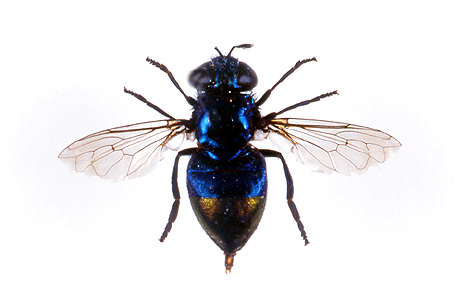
Diptera - The Flies
Around since the Permian period (225-280 million years ago), flies are one of the most ubiquitous insects. They are found on every continent, including Antarctica (a rare boast indeed!). In fact, at a length of only 1.3cm (0.5”), the wingless midge Belgica antarctica is Antarctica’s second largest terrestrial animal - beaten only by a slightly larger springtail! It should also be noted that flies are the stowaways that turn up most often at McMurdo Station. Adaptable and resilient, flies are one of the few insects that can thrive under cool conditions, often making up a quarter of the insect population in temperate regions. Another unusual trait among flies is their association with marine habitats. Tolerable of all sorts of alkaline conditions, they can be found in association with many saltwater habitats, right up to the littoral zone - and beyond! Flightless midges in the genus Pontomyia (found throughout the Indo-Pacific) have dared to go where no insects tread: the depths of the ocean!! Adult males skate around on the surface of the sea where they seek out the strange larvae-like females. Eggs are laid immediately after mating (embedded in a gelatinous matrix) as a long coil, which sinks to the bottom. Larvae feed at depths of up to 30 meters! Pupae float back to the surface shortly before emergence. To top it all off, these midges have the shortest adult life span of all known insects: a mere 30 minutes to 3 hours! In addition to these feats of greatness, flies stand out among other insects by having only a single pair of wings. The word Diptera comes from the Greek words for "two-wing", making reference to this unique phenomenon (all other winged insects, except the mysterious Stylopids, have two pairs of wings). The fly’s other pair of wings has evolved into structures called "halteres". Sense organs in the bases of these halteres allow them to act as gyroscopes, telling the fly how fast it is flying or turning and whether or not it is being blown off course. Flies do not have chewing mouthparts. Instead, with the aid of powerful pumps in their heads, a fly's mouthparts are adapted for sucking up liquefied nutrients. Although often repulsive in their choice of food, they play an important role in the environment and help to keep Earth from becoming a huge sphere of rotting biomass. With about 90,000 known species, fly larvae (maggots) consume all kinds of unpleasant things; fungi, dung, animal corpses and all manner of foul, rotten, organic material. Other kinds of maggots are parasitic; some feeding within the bodies of mammalian hosts. Many species have aquatic larvae, while a host of others mine the roots, stems, and leaves of plants. Adult flies live as many interesting, varied lives as their larvae, generally relying on food sources very different from that of the larvae. A classic example of this is the mosquito. As an adult, the males feed on nectar and the females on blood. The larvae however, live in shallow, fresh water, feeding on organic detritus, algae and tiny, aquatic organisms. Many species of flies that are known vectors for disease are still considered a pest throughout much of Earth’s equatorial lands. Looking on the bright side, it is a kind of tiny fly, a midge (Forcipomyia[=Rhynchoforcipomyia]spp.), that is the sole pollinator of the cacao tree, the only known source of cacao - the main component of chocolate!
 Blue-Bottle Flies (Calliphora vomitoria & Calliphora vicina)
Blue-Bottle Flies (Calliphora vomitoria & Calliphora vicina)
![]() Hover Fly & Drone Fly (Helophilus sp. & Eristalis tenax)
Hover Fly & Drone Fly (Helophilus sp. & Eristalis tenax)




